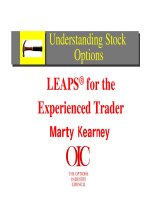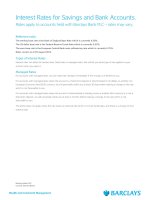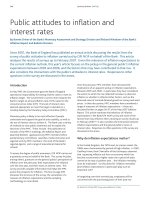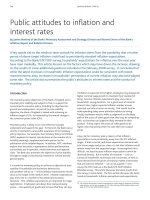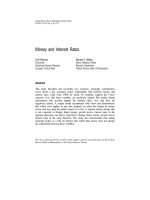QUANTUM FINANCE Path Integrals and Hamiltonians for Options and Interest Rates doc
Bạn đang xem bản rút gọn của tài liệu. Xem và tải ngay bản đầy đủ của tài liệu tại đây (1.58 MB, 334 trang )
This page intentionally left blank
QUANTUM FINANCE
Path Integrals and Hamiltonians for Options and Interest Rates
This book applies the mathematics and concepts of quantum mechanics and quan-
tum field theory to the modelling of interest rates and the theory of options.
Particular emphasis is placed on path integrals and Hamiltonians.
Financial mathematics at present is almost completely dominated by stochastic
calculus. This book is unique in that it offers a formulation that is completely
independent of that approach. As such many new results emerge from the ideas
developed by the author.
This pioneering work will be of interest to physicists and mathematicians work-
ing in the field of finance, to quantitative analysts in banks and finance firms, and to
practitioners in the field of fixed income securities and foreign exchange. The book
can also be used as a graduate text for courses in financial physics and financial
mathematics.
B
ELAL E. BAAQUIE earned his B.Sc. from Caltech and Ph.D. in theoretical
physics from Cornell University. He has published over 50 papers in leading inter-
national journals on quantum field theory and related topics, and since 1997 has
regularly published papers on applying quantum field theory to both the theoretical
and empirical aspects of finance. He helped to launch the International Journal of
Theoretical and Applied Finance in 1998 and continues to be one of the editors.
QUANTUM FINANCE
Path Integrals and Hamiltonians for Options and Interest Rates
BELAL E. BAAQUIE
National University of Singapore
CAMBRIDGE UNIVERSITY PRESS
Cambridge, New York, Melbourne, Madrid, Cape Town, Singapore, São Paulo
Cambridge University Press
The Edinburgh Building, Cambridge CB2 8RU, UK
First published in print format
ISBN-13 978-0-521-84045-3
ISBN-13 978-0-511-26469-6
© B. E. Baaquie 2004
2004
Informationonthistitle:www.cambrid
g
e.or
g
/9780521840453
This publication is in copyright. Subject to statutory exception and to the provision of
relevant collective licensing agreements, no reproduction of any part may take place
without the written permission of Cambridge University Press.
ISBN-10 0-511-26469-0
ISBN-10 0-521-84045-7
Cambridge University Press has no responsibility for the persistence or accuracy of urls
for external or third-party internet websites referred to in this publication, and does not
guarantee that any content on such websites is, or will remain, accurate or appropriate.
Published in the United States of America by Cambridge University Press, New York
www.cambridge.org
hardback
eBook (EBL)
eBook (EBL)
hardback
I dedicate this book to my father Mohammad Abdul Baaquie and to the memory
of my mother Begum Ajmeri Roanaq Ara Baaquie, for their precious lifelong
support and encouragement.
Contents
Foreword page xi
Preface xiii
Acknowledgments xv
1 Synopsis 1
Part I Fundamental concepts of finance
2 Introduction to finance 7
2.1 Efficient market: random evolution of securities 9
2.2 Financial markets 11
2.3 Risk and return 13
2.4 Time value of money 15
2.5 No arbitrage, martingales and risk-neutral measure 16
2.6 Hedging 18
2.7 Forward interest rates: fixed-income securities 20
2.8 Summary 23
3 Derivative securities 25
3.1 Forward and futures contracts 25
3.2 Options 27
3.3 Stochastic differential equation 30
3.4 Ito calculus 31
3.5 Black–Scholes equation: hedged portfolio 34
3.6 Stock price with stochastic volatility 38
3.7 Merton–Garman equation 39
3.8 Summary 41
3.9 Appendix: Solution for stochastic volatility with ρ = 041
Part II Systems with finite number of degrees of freedom
4 Hamiltonians and stock options 45
4.1 Essentials of quantum mechanics 45
4.2 State space: completeness equation 47
vii
viii Contents
4.3 Operators: Hamiltonian 49
4.4 Black–Scholes and Merton–Garman Hamiltonians 52
4.5 Pricing kernel for options 54
4.6 Eigenfunction solution of the pricing kernel 55
4.7 Hamiltonian formulation of the martingale condition 59
4.8 Potentials in option pricing 60
4.9 Hamiltonian and barrier options 62
4.10 Summary 66
4.11 Appendix: Two-state quantum system (qubit) 66
4.12 Appendix: Hamiltonian in quantum mechanics 68
4.13 Appendix: Down-and-out barrier option’s pricing kernel 69
4.14 Appendix: Double-knock-out barrier option’s pricing kernel 73
4.15 Appendix: Schrodinger and Black–Scholes equations 76
5 Path integrals and stock options 78
5.1 Lagrangian and action for the pricing kernel 78
5.2 Black–Scholes Lagrangian 80
5.3 Path integrals for path-dependent options 85
5.4 Action for option-pricing Hamiltonian 86
5.5 Path integral for the simple harmonic oscillator 86
5.6 Lagrangian for stock price with stochastic volatility 90
5.7 Pricing kernel for stock price with stochastic volatility 93
5.8 Summary 96
5.9 Appendix: Path-integral quantum mechanics 96
5.10 Appendix: Heisenberg’s uncertainty principle in finance 99
5.11 Appendix: Path integration over stock price 101
5.12 Appendix: Generating function for stochastic volatility 103
5.13 Appendix: Moments of stock price and stochastic volatility 105
5.14 Appendix: Lagrangian for arbitrary α 107
5.15 Appendix: Path integration over stock price for arbitrary α 108
5.16 Appendix: Monte Carlo algorithm for stochastic volatility 111
5.17 Appendix: Merton’s theorem for stochastic volatility 115
6 Stochastic interest rates’ Hamiltonians and path integrals 117
6.1 Spot interest rate Hamiltonian and Lagrangian 117
6.2 Vasicek model’s path integral 120
6.3 Heath–Jarrow–Morton (HJM) model’s path integral 123
6.4 Martingale condition in the HJM model 126
6.5 Pricing of Treasury Bond futures in the HJM model 130
6.6 Pricing of Treasury Bond option in the HJM model 131
6.7 Summary 133
6.8 Appendix: Spot interest rate Fokker–Planck Hamiltonian 134
Contents ix
6.9 Appendix: Affine spot interest rate models 138
6.10 Appendix: Black–Karasinski spot rate model 139
6.11 Appendix: Black–Karasinski spot rate Hamiltonian 140
6.12 Appendix: Quantum mechanical spot rate models 143
Part III Quantum field theory of interest rates models
7 Quantum field theory of forward interest rates 147
7.1 Quantum field theory 148
7.2 Forward interest rates’ action 151
7.3 Field theory action for linear forward rates 153
7.4 Forward interest rates’ velocity quantum field A(t, x) 156
7.5 Propagator for linear forward rates 157
7.6 Martingale condition and risk-neutral measure 161
7.7 Change of numeraire 162
7.8 Nonlinear forward interest rates 164
7.9 Lagrangian for nonlinear forward rates 165
7.10 Stochastic volatility: function of the forward rates 168
7.11 Stochastic volatility: an independent quantum field 169
7.12 Summary 172
7.13 Appendix: HJM limit of the field theory 173
7.14 Appendix: Variants of the rigid propagator 174
7.15 Appendix: Stiff propagator 176
7.16 Appendix: Psychological future time 180
7.17 Appendix: Generating functional for forward rates 182
7.18 Appendix: Lattice field theory of forward rates 183
7.19 Appendix: Action S
∗
for change of numeraire 188
8 Empirical forward interest rates and field theory models 191
8.1 Eurodollar market 192
8.2 Market data and assumptions used for the study 194
8.3 Correlation functions of the forward rates models 196
8.4 Empirical correlation structure of the forward rates 197
8.5 Empirical properties of the forward rates 201
8.6 Constant rigidity field theory model and its variants 205
8.7 Stiff field theory model 209
8.8 Summary 214
8.9 Appendix: Curvature for stiff correlator 215
9 Field theory of Treasury Bonds’ derivatives and hedging 217
9.1 Futures for Treasury Bonds 217
9.2 Option pricing for Treasury Bonds 218
9.3 ‘Greeks’ for the European bond option 220
9.4 Pricing an interest rate cap 222
x Contents
9.5 Field theory hedging of Treasury Bonds 225
9.6 Stochastic delta hedging of Treasury Bonds 226
9.7 Stochastic hedging of Treasury Bonds: minimizing variance 228
9.8 Empirical analysis of instantaneous hedging 231
9.9 Finite time hedging 235
9.10 Empirical results for finite time hedging 237
9.11 Summary 240
9.12 Appendix: Conditional probabilities 240
9.13 Appendix: Conditional probability of Treasury Bonds 242
9.14 Appendix: HJM limit of hedging functions 244
9.15 Appendix: Stochastic hedging with Treasury Bonds 245
9.16 Appendix: Stochastic hedging with futures contracts 248
9.17 Appendix: HJM limit of the hedge parameters 249
10 Field theory Hamiltonian of forward interest rates 251
10.1 Forward interest rates’ Hamiltonian 252
10.2 State space for the forward interest rates 253
10.3 Treasury Bond state vectors 260
10.4 Hamiltonian for linear and nonlinear forward rates 260
10.5 Hamiltonian for forward rates with stochastic volatility 263
10.6 Hamiltonian formulation of the martingale condition 265
10.7 Martingale condition: linear and nonlinear forward rates 268
10.8 Martingale condition: forward rates with stochastic volatility 271
10.9 Nonlinear change of numeraire 272
10.10 Summary 274
10.11 Appendix: Propagator for stochastic volatility 275
10.12 Appendix: Effective linear Hamiltonian 276
10.13 Appendix: Hamiltonian derivation of European bond option 277
11 Conclusions 282
A Mathematical background 284
A.1 Probability distribution 284
A.2 Dirac Delta function 286
A.3 Gaussian integration 288
A.4 White noise 292
A.5 The Langevin Equation 293
A.6 Fundamental theorem of finance 296
A.7 Evaluation of the propagator 298
Brief glossary of financial terms 301
Brief glossary of physics terms 303
List of main symbols 305
References 310
Index 315
Foreword
After a few early isolated cases in the 1980s, since the mid-1990s hundreds of pa-
pers dealing with economics and finance have invaded the physics preprint server
xxx.lanl.gov/cond-mat, initially devoted to condensed matter physics, and now
covering subjects as different as computer science, biology or probability theory.
The flow of paper posted on this server is still increasing – roughly one per day –
addressing a range of problems, from financial data analysis to analytical option-
pricing methods, agent-based models of financial markets and statistical models
of wealth distribution or company growth. Some papers are genuinely beautiful,
others are rediscoveries of results known by economists, and unfortunately some
are simply crazy.
A natural temptation is to apply the tools one masters to other fields. In the
case of physics and finance, this temptation is extremely strong. The sophisticated
tools developed in the last 50 years to deal with statistical mechanics and quantum
mechanics problems are often of immediate interest in finance and in economics.
Perturbation theory, path integral (Feynman–Kac) methods, random matrix and
spin-glass theory are useful for option pricing, portfolio optimization and game
theoretical situations, and many new insights have followed from such transfers of
knowledge.
Within theoretical physics, quantum field theory has a special status and is re-
garded by many as the queen of disciplines, that has allowed one to unravel the
most intimate intricacies of nature, from quantum electrodynamics to critical phe-
nomena. In the present book, Belal Baaquie tells us how these methods can be
applied to finance problems, and in particular to the modelling of interest rates.
The interest rate curve can be seen as a string of numbers, one for each maturity,
fluctuating in time. The ‘one-dimensional’ nature of these randomly fluctuating
rates imposes subtle correlations between different maturities, that are most natu-
rally described using quantum field theory, which was indeed created to deal with
nontrivial correlations between fluctuating fields. The level of complexity of the
xi
xii Foreword
bond market (reflecting the structure of the interest rate curve) and its derivatives
(swaps, caps, floors, swaptions) requires a set of efficient and adapted techniques.
My feeling is that the methods of quantum field theory, which naturally grasp
complex structures, are particularly well suited for this type of problems. Belal
Baaquie’s book, based on his original work on the subject, is particularly useful
for those who want to learn techniques which will become, in a few years, un-
avoidable. Many new ideas and results improving our understanding of interest
rate markets will undoubtedly follow from an in-depth exploration of the paths
suggested in this fascinating (albeit sometimes demanding) opus.
Jean-Philippe Bouchaud
Capital Fund Management and CEA-Saclay
Preface
Financial markets have undergone tremendous growth and dramatic changes in the
past two decades, with the volume of daily trading in currency markets hitting over
a trillion US dollars and hundreds of billions of dollars in bond and stock markets.
Deregulation and globalization have led to large-scale capital flows; this has raised
new problems for finance as well as has further spurred competition among banks
and financial institutions.
The resulting booms, bubbles and busts of the global financial markets now
directly affect the lives of hundreds of millions of people, as was witnessed during
the 1998 East Asian financial crisis.
The principles of banking and finance are fairly well established [16,76,87] and
the challenge is to apply these principles in an increasingly complicated environ-
ment. The immense growth of financial markets, the existence of vast quantities of
financial data and the growing complexity of the market, both in volume and so-
phistication, has made the use of powerful mathematical and computational tools
in finance a necessity. In order to meet the needs of customers, complex financial
instruments have been created; these instruments demand advanced valuation and
risk assessment models and systems that quantify the returns and risks for investors
and financial institutions [63, 100].
The widespread use in finance of stochastic calculus and of partial differen-
tial equations reflects the traditional presence of probabilists and applied mathem-
aticians in this field. The last few years has seen an increasing interest of theor-
etical physicists in the problems of applied and theoretical finance. In addition to
the vast corpus of literature on the application of stochastic calculus to finance,
concepts from theoretical physics have been finding increasing application in both
theoretical and applied finance. The influx of ideas from theoretical physics, as
expressed for example in [18] and [69], has added a whole collection of new math-
ematical and computational techniques to finance, from the methods of classical
and quantum physics to the use of path integration, statistical mechanics and so
xiii
xiv Preface
on. This book is part of the on-going process of applying ideas from physics to
finance.
The long-term goal of this book is to contribute to a quantum theory of finance;
towards this end the theoretical tools of quantum physics are applied to problems in
finance. The larger question of applying the formalism and insights of (quantum)
physics to economics, and which forms a part of the larger subject of econophysics
[88, 89], is left for future research.
The mathematical background required of the readership is the following:
r
A good grasp of calculus
r
Familiarity with linear algebra
r
Working knowledge of probability theory
The material covered in this book is primarily meant for physicists and mathe-
maticians conducting research in the field of finance, as well as professional theo-
rists working in the finance industry. Specialists working in the field of derivative
instruments, corporate and Treasury Bonds and foreign currencies will hopefully
find that the theoretical tools and mathematical ideas introduced in this book broad-
ens their repertoire of quantitative approaches to finance.
This book could also be of interest to researchers from the theoretical sciences
who are thinking of pursuing research in the field of finance as well as graduates
students with the required mathematical training. An earlier draft of this book was
taught as an advanced graduate course to a group of students from financial engi-
neering, physics and mathematics.
Given the diverse nature of the potential audience, fundamental concepts of fi-
nance have been reviewed to motivate readers new to the field. The chapters on ‘In-
troduction to finance’ and on ‘Derivative securities’ are meant for physicists and
mathematicians unfamiliar with concepts of finance. On the other hand, discus-
sions on quantum mechanics and quantum field theory are meant to introduce spe-
cialists working in finance and in mathematics to concepts from quantum theory.
Acknowledgments
I am deeply grateful to Lawrence Ma for introducing me to the subject of theoret-
ical finance; most of my initial interest in mathematical finance is a result of the
patient explanations of Lawrence.
I thank Jean-Philippe Bouchaud for instructive and enjoyable discussions, and
for making valuable suggestions that have shaped my thinking on finance; the
insights that Jean-Philippe brings to the interface of physics and finance have been
particularly enlightening.
I would like to thank Toh Choon Peng, Sanjiv Das, George Chacko, Mitch
Warachka, Omar Foda, Srikant Marakani, Claudio Coriano, Michael Spalinski,
Bertrand Roehner, Bertrand Delamotte, Cui Liang and Frederick Willeboordse for
many helpful and stimulating interactions.
I thank the Department of Physics, the Faculty of Science and the National Uni-
versity of Singapore for their steady and unwavering support and Research Grants
that were indispensable for sustaining my trans-disciplinary research in physics
and finance.
I thank Science and Finance for kindly providing data on Eurodollar futures, and
the Laboratoire de Physique Th
´
eorique et Hautes Energies, Universit
´
es Paris 6 et 7,
and in particular Franc¸ois Martin, for their kind hospitality during the completion
of this book.
xv
1
Synopsis
Two underlying themes run through this book: first, defining and analyzing the
subject of quantitative finance in the conceptual and mathematical framework of
quantum theory, with special emphasis on its path-integral formulation, and, sec-
ond, the introduction of the techniques and methodology of quantum field theory
in the study of interest rates.
No attempt is made to apply quantum theory in re-working the fundamental
principles of finance. Instead, the term ‘quantum’ refers to the abstract mathemati-
cal constructs of quantum theory that include probability theory, state space, opera-
tors, Hamiltonians, commutation equations, Lagrangians, path integrals, quantized
fields, bosons, fermions and so on. All these theoretical structures find natural and
useful applications in finance.
The path integral and Hamiltonian formulations of (random) quantum processes
have been given special emphasis since they are equivalent to, as well as indepen-
dent of, the formalism of stochastic calculus – which currently is one of the cor-
nerstones of mathematical finance. The starting point for the application of path
integrals and Hamiltonians in finance is in stock option pricing. Path integrals are
subsequently applied to the modelling of linear and nonlinear theories of inter-
est rates as a two-dimensional quantum field, something that is beyond the scope
of stochastic calculus. Path integrals have the additional advantage of providing a
framework for efficiently implementing the mathematical procedure of renormal-
ization which is necessary in the study of nonlinear quantum field theories.
The term ‘Quantum Finance’ represents the synthesis of the concepts, meth-
ods and mathematics of quantum theory, with the field of theoretical and applied
finance.
To ease the reader’s transition to the mathematics of quantum theory, and of
path integration in particular, the presentation of new material starts in a few
cases with well-established models of finance. New ideas are introduced by first
carrying out the relatively easier exercise of recasting well-known results in the
1
2 Quantum Finance
formalism of quantum theory, and then going on to derive new results. One unex-
pected advantage of this approach is that theorists, working in the field of finance –
presently focussed on notions drawn from stochastic calculus and partial differen-
tial equations – obtain a formalism that completely parallels and mirrors stochastic
calculus, and prepares the ground for a (smooth) transition to the mathematics of
quantum field theory.
All important equations are derived from first principles of finance and, as far
as possible, a complete and self-contained mathematical treatment of the main re-
sults is given. A few of the exactly soluble models that appear in finance are closely
studied since these serve as exemplars for demonstrating the general principles of
quantum finance. In particular, the workings of the path-integral and Hamiltonian
formulations are demonstrated by concretely working out, in complete mathemat-
ical detail, some of the more instructive models. The models themselves are in-
teresting in their own right, thus providing a realistic context for developing the
applications of path integrals to finance.
The book consists of the following three major components:
1
Fundamental concepts of finance
The standard concepts of finance and equations of option theory are reviewed in
this component.
Chapter 2 is an ‘Introduction to finance’ that is meant for readers who are unfa-
miliar with the essential ideas of finance. Fundamental concepts and terminology
of finance, necessary for understanding the particular set of equations that arise in
finance, are introduced. In particular, the concepts of risk and return, time value of
money, arbitrage, hedging and, finally, Treasury Bonds and fixed-income securities
are briefly discussed.
Chapter 3 on ‘Derivative securities’ introduces the concept of financial deriva-
tives and discusses the pricing of derivatives. The classic analysis of Black and
Scholes is discussed, the mathematics of stochastic calculus briefly reviewed and
the connection of stochastic processes with the Langevin equation is elaborated. A
derivation from first principles is given of the price of a stock option with stochas-
tic volatility. The material covered in these two chapters is standard, and defines
the framework and context for the next two chapters.
Systems with finite number of degrees of freedom
In this part Hamiltonians and path integrals are applied to the study of stock options
and stochastic interest rates models. These models are characterized by having
1
The path-integral formulation of problems in finance opens the way for applying powerful computational al-
gorithms; these numerical algorithms are a specialized subject, and are not addressed except for a passing
reference in Section 5.16.
Synopsis 3
finite number of degrees of freedom, which is defined to be the number of inde-
pendent random variables at each instant of time t. Examples of such systems
are a randomly evolving equity S(t) or the spot interest rate r(t), each of which
have one degree of freedom. All quantities computed for quantum systems with
a finite number of degrees of freedom are completely finite, and do not need the
procedure of renormalization to have a well-defined value.
In Chapter 4 on ‘Hamiltonians and stock options’, the problem of the pric-
ing of derivative securities is recast as a problem of quantum mechanics, and
the Hamiltonians driving the prices of options are derived for both stock prices
with constant and stochastic volatility. The martingale condition required for risk-
neutral evolution is re-expressed in terms of the Hamiltonian. Potential terms in
the Hamiltonian are shown to represent a class of path-dependent options. Barrier
options are solved exactly using the appropriate Hamiltonian.
In Chapter 5 on ‘Path integrals and stock options’, the problem of option pricing
is expressed as a Feynman path integral. The Hamiltonians derived in the previous
chapter provide a link between the partial differential equations of option pricing
and its path-integral realization. A few path integrals are explicitly evaluated to il-
lustrate the mathematics of path integration. The case of stock price with stochastic
volatility is solved exactly, as this is a nontrivial problem which is a good exemplar
for illustrating the subtleties of path integration.
Certain exact simplifications emerge due to the path-integral representation of
stochastic volatility and lead to an efficient Monte Carlo algorithm that is discussed
to illustrate the numerical aspects of the path integral.
In Chapter 6 on ‘Stochastic interest rates’ Hamiltonians and path integrals’, some
of the important existing stochastic models for the spot and forward interest rates
are reviewed. The Fokker–Planck Hamiltonian and path integral are obtained for
the spot interest rate, and a path-integral solution of the Vasicek model is presented.
The Heath–Jarrow–Morton (HJM) model for the forward interest rates is recast
as a problem of path integration, and well-known results of the HJM model are
re-derived using the path integral.
Chapter 6 is a preparation for the main thrust of this book, namely the applica-
tion of quantum field theory to the modelling of the interest rates.
Quantum field theory of interest rates models
Quantum field theory is a mathematical structure for studying systems that have
infinitely many degrees of freedom; there are many new features that emerge for
such systems that are beyond the formalism of stochastic calculus, the most im-
portant being the concept of renormalization for nonlinear field theories. All the
chapters in this part treat the forward interest rates as a quantum field.
4 Quantum Finance
In Chapter 7 on ‘Quantum field theory of forward interest rates’, the formalism
of path integration is applied to a randomly evolving curve: the forward interest
rates are modelled as a randomly fluctuating curve that is naturally described by
quantum field theory. Various linear (Gaussian) models are studied to illustrate
the theoretical flexibility of the field theory approach. The concept of psychologi-
cal future time is shown to provide a natural extension of (Gaussian) field theory
models. The martingale condition is solved for Gaussian models, and a field the-
ory derivation is given for the change of numeraire. Nonlinear field theories are
shown to arise naturally in modelling positive-valued forward interest rates as well
as forward rates with stochastic volatility.
In Chapter 8 on ‘Empirical forward interest rates and field theory models’, the
empirical aspects of the forward rates are discussed in some detail, and it is shown
how to calibrate and test field theory models using market data on Eurodollar fu-
tures. The most important result of this chapter is that a so-called ‘stiff’ Gaussian
field theory model provides an almost exact fit for the market behaviour of the for-
ward rates. The empirical study provides convincing evidence on the efficacy of
the field theory in modelling the behaviour of the forward interest rates.
In Chapter 9 on ‘Field theory of Treasury Bonds’ derivatives and hedging’, the
pricing of Treasury Bond futures, bond options and interest caps are studied. The
hedging of Treasury Bonds in field theory models of interest rates is discussed,
and is shown to be a generalization of the more standard approaches. Exact results
for both instantaneous and finite time hedging are derived, and a semi-empirical
analysis of the results is carried out.
In Chapter 10 on ‘Field theory Hamiltonian of the forward interest rates’ the
state space and Hamiltonian is derived for linear and nonlinear theories. The
Hamiltonian formulation yields an exact solution of the martingale condition for
the nonlinear forward rates, as well as for forward rates with stochastic volatility. A
Hamiltonian derivation is given of the change of numeraire for nonlinear theories,
of bond option price, and of the pricing kernel for the forward interest rates.
All chapters focus on the conceptual and theoretical aspects of the quantum
formalism as applied to finance, with material of a more mathematical nature be-
ing placed in the Appendices that follow each chapter. In a few instances where
the reader might benefit from greater detail the derivations are included in the
main text, but in a smaller font size. The Appendix at the end of the book con-
tains mathematical results that are auxiliary to the material covered in the book.
The reason for including the Appendices is to present a complete and compre-
hensive treatment of all the topics discussed, and a reader who intends to carry out
some computations would find this material useful. In principle, the Appendices
and the derivations in smaller type can be skipped without any loss of continuity.
Part I
Fundamental concepts of finance
2
Introduction to finance
The field of economics is primarily concerned with the various forms of productive
activities required to sustain the material and spiritual life of society. Real assets,
such as capital goods, management and labour force, and so on, are necessary for
producing goods and services required for the survival and prosperity of society.
The term capital denotes the economic value of the real assets of a society. In
most developed economies, economic assets have a monetized form, and capital
can be given a monetary value or paper form, called the money form of capital.
Finance is a branch of economics that studies the money (paper) form of capital.
Uncertainty and risk are of fundamental importance in finance [87].
The main focus in this book is on financial assets and financial instruments.
Financial assets, in contrast to real assets, are pieces of paper that entitle its holder
to a claim on a fraction of the real assets, and to the income (if any) that is generated
by these real assets. For example, a person owning a stock of a company is entitled
to yearly dividends (if any), and to a pro rata fraction of the assets if the company
liquidates.
What distinguishes finance from other branches of economics is that it is pri-
marily an empirical discipline due to the demands of the finance industry. Vast
quantities of financial data are generated every day, in addition to mountains of
accumulated historical data. Unlike other branches of economics, the empirical
nature of finance makes it closer to the natural sciences, since the financial mar-
kets impose the need for practical and transparent quantitative models that can be
calibrated and tested.
A financial asset is also called a security, and the specific form of a financial
asset – be it a stock or a bond – is called a financial instrument. A financial as-
set is at the same time a financial liability for the issuing party, since its profit
and assets are to be divided amongst all the stockholders. Stocks and bonds are in
positive net supply. Derivatives in contrast are in zero net supply since the num-
ber of people holding the derivative exactly equals the number of people selling
7



